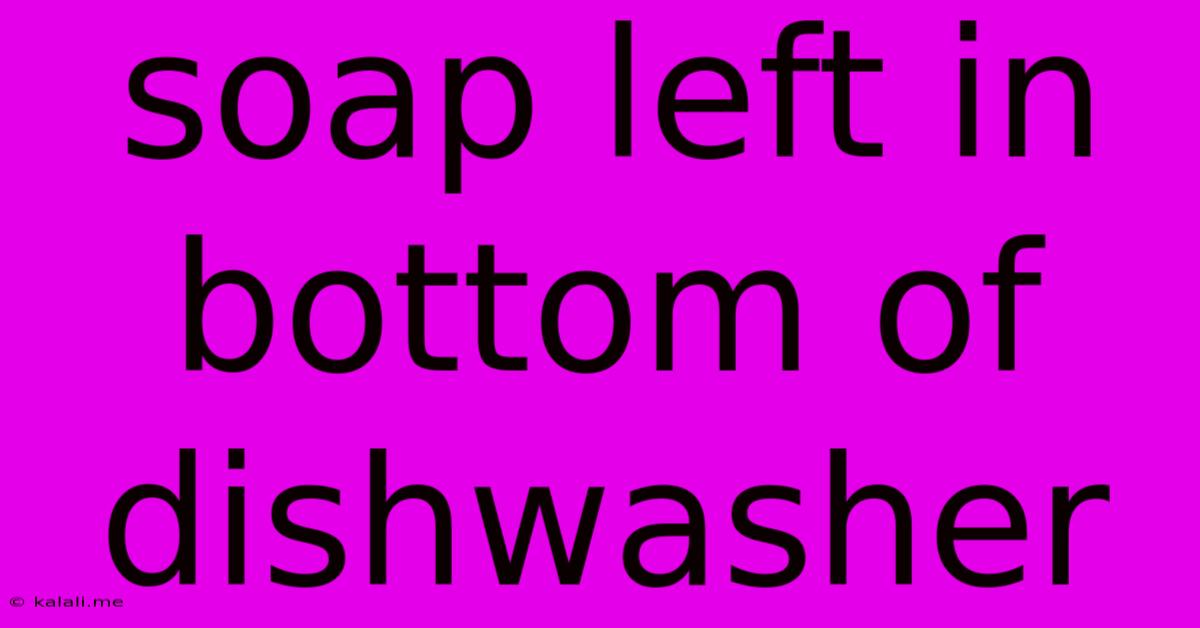Soap Left In Bottom Of Dishwasher
Kalali
Jun 01, 2025 · 3 min read

Table of Contents
The Mystery of the Sudsy Bottom: Why Soap Remains in Your Dishwasher
Finding soap residue at the bottom of your dishwasher is frustrating. It suggests a problem, not just a cosmetic one, but potentially affecting the cleanliness of your dishes. This article explores the common culprits behind this persistent problem and offers practical solutions to get your dishwasher sparkling clean – and keep it that way.
Why is soap left at the bottom of my dishwasher? This common issue often stems from several factors, and pinpointing the cause is key to resolving it. Understanding the underlying mechanics of your dishwasher is a great first step.
Common Causes of Soap Residue
-
Insufficient Water Pressure: Low water pressure prevents the detergent from being fully dissolved and dispersed throughout the wash cycle. This leaves a build-up of undissolved soap at the bottom. Check your home's water pressure; a low reading may require a plumber's attention.
-
Clogged Spray Arms: The dishwasher's spray arms are responsible for distributing water and detergent. If these arms are clogged with food particles or mineral deposits, the cleaning solution won't reach all areas effectively, leaving soap behind. Regularly inspect and clean your spray arms.
-
Detergent Issues: The type and amount of detergent play a significant role. Using too much detergent can lead to excess residue, as can using a detergent that's not formulated for your dishwasher type (powder vs. gel/pods). Experiment with a different brand or try reducing the amount you use.
-
Faulty Dispenser: The detergent dispenser might be malfunctioning, preventing the detergent from releasing properly during the wash cycle. Inspect the dispenser for any blockages or signs of damage. A broken dispenser might need replacement.
-
Hard Water: Hard water contains high levels of minerals that can interfere with detergent dissolving and contribute to residue. Using a water softener or adding a rinse aid can alleviate this.
-
Incorrect Loading: Overcrowding the dishwasher can hinder the water flow and prevent proper cleaning, leaving soap at the bottom. Ensure dishes are properly spaced to allow water to circulate freely.
Troubleshooting and Solutions
Let's delve into specific solutions for each problem:
1. Check Water Pressure: Contact your local water utility to check your water pressure. Low pressure needs professional attention.
2. Clean Spray Arms: Remove the spray arms and thoroughly clean them under running water, using a small brush or toothpick to remove stubborn clogs.
3. Adjust Detergent: Experiment with different detergents, focusing on those designed for your dishwasher type and hard water conditions. Consider reducing the amount you use, following the manufacturer's recommendations.
4. Inspect the Dispenser: Examine the detergent dispenser for any clogs or damage. If necessary, consult your dishwasher's manual for cleaning or replacement instructions.
5. Soften Your Water: If you have hard water, consider installing a water softener or regularly using a rinse aid to help dissolve minerals.
6. Improve Loading Technique: Ensure that dishes are not overcrowded, allowing for ample space between items. Avoid stacking dishes in a way that blocks water flow.
7. Deep Clean Your Dishwasher: Run a cycle with only white vinegar in the detergent dispenser to clean and deodorize the machine. Follow this with a cycle using baking soda in the bottom of the dishwasher.
By systematically addressing these points, you can pinpoint the cause of the persistent soap residue and restore your dishwasher to its efficient, clean-operating state. Remember, a clean dishwasher translates to cleaner dishes!
Latest Posts
Latest Posts
-
Gta V Smoke On The Water
Jun 03, 2025
-
How Many Ticks In A Second Minecraft
Jun 03, 2025
-
Electric Field Inside Parallel Plate Capacitor
Jun 03, 2025
-
How To Remove Tin Foil From Bottom Of Oven
Jun 03, 2025
-
How To Use Continuity To Evaluate The Limit
Jun 03, 2025
Related Post
Thank you for visiting our website which covers about Soap Left In Bottom Of Dishwasher . We hope the information provided has been useful to you. Feel free to contact us if you have any questions or need further assistance. See you next time and don't miss to bookmark.